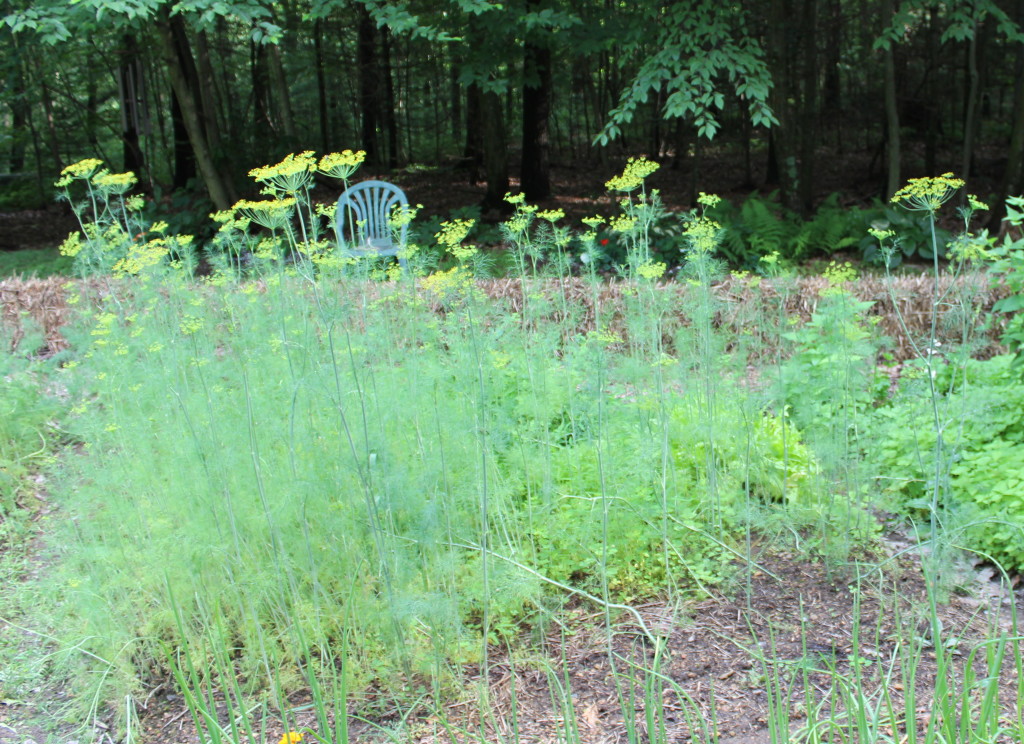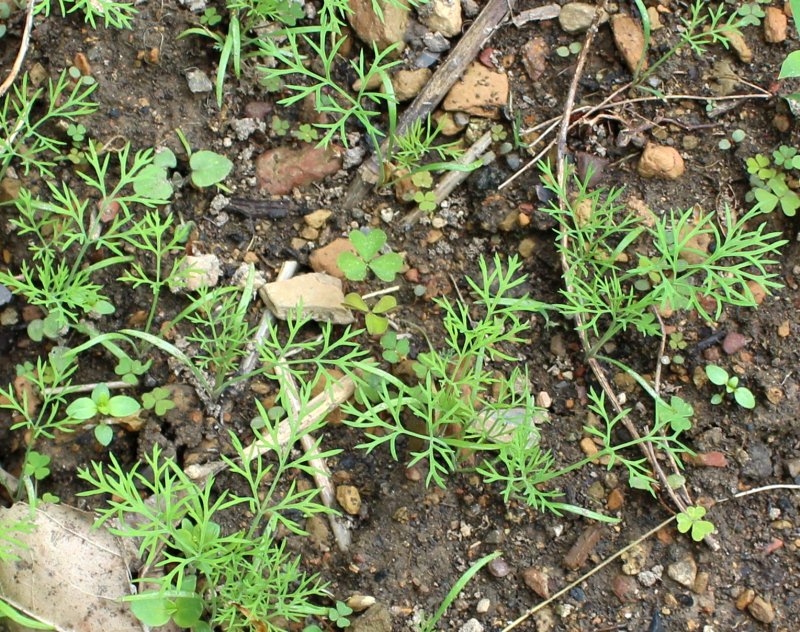Herb: Dill
Dill, Anethum graveolens, is a culinary herb used to flavor pickles, vegetables and other foods.
Dill will reseed itself if allowed to set seed the prior year. Several varieties are available, such as dwarf varieties suitable for container gardens, and other varieties that produce large crops of leaves or seeds. The dark green, finely divided leaves contrast nicely with the yellow-green flower tops and seed heads.
Dill Characteristics
- annual reaching to 4 feet tall
- leaves finely divided into narrow strips
- scent of “pickles” to leaves and seeds
- tiny yellow flowers in circular groups in flat clusters
- seeds mature at top of umbels
- cultivated in gardens for culinary use
Dill Uses
- culinary
- gardening
Growing Dill
Growing conditions: Dill is not too picky whether it grows in sunny or partly sunny locations. Dill can be intercropped with other garden favorites, such as asparagus, and let go to seed for its renewal the following year.
Light: sun, partial shade
Height: 36 inches
Spacing: 12 inches
Planting comments: Seed directly after the danger of frost has passed for your area. Seeds germininate between 60 and 75 degrees F. Does not transplant well.
Where to Buy Dill
Dill is available as seeds or plants. Depending on the time of year you may be able to find a plant at your nearby garden center. In case they’re are not available locally, here are some places that offer herb seeds and herb plants.
- Abundant Life Seeds Cottage Grove, OR
- Artistic Gardens / Le Jardin du Gourmet St. Johnsbury Center, VT
- Baker Creek Heirloom Seeds Mansfield, MO
- Bluestone Perennials, Inc. Madison, OH
- BorgheseGardens.com Gautier, MS
- Bountiful Gardens Palo Alto, CA
- Companion Plants Athens, OH
- Ed Hume Seeds Puyallup, WA
- Eden Organic Nursery Services, Inc. Davie, FL
- Garden Medicinals and Culinaries Mineral, VA
- GreenDealer Exotic Seeds Louisville, KY
- Heirloom Seeds West Elizabeth, PA
- Henry Field Seed and Nursery Co. Aurora, IN
- High Altitude Gardens Cornville, AZ
- Irish Eyes Garden Seeds Ellensburg, WA
- Jim Johnson, Seedman Gautier, MS
- John Scheepers Kitchen Garden Seeds, LLC. Bantam, CT
- Johnny’s Selected Seeds Winslow, ME
- Jung Quality Seeds Randolph, WI
- Logee’s Greenhouses, Ltd. Danielson, CT
- NESEED.com Hartford, CT
- Nichols Garden Nursery Albany, OR
- Ornamental Edibles San Jose, CA
- Otto Richter and Sons Limited. Goodwood, ON, Canada
- Peaceful Valley Farm Supply, Inc. Grass Valley, CA
- Pepper Gal Fort Lauderdale, FL
- Peters Seed and Research may be out of business,
- Pinetree Garden Seeds New Gloucester, ME
- R.H. Shumway’s Randolph, WI
- Redwood City Seed Co. Redwood City, CA
- Renee’s Garden Seeds Felton, CA
- Seed Savers Exchange Decorah, IA
- Southern Exposure Seed Exchange Mineral, VA
- Stokes Seeds Inc. Buffalo, NY
- The Cook’s Garden Warminster, PA
- Thompson and Morgan Jackson, NJ
- Underwood Gardens Chino Valley, AZ
- Veseys Seeds Ltd. Calais, ME
- Victory Seed Company Molalla, OR
- W. Atlee Burpee & Co. Warminster, PA
- Willhite Seed, Inc. Poolville, TX
In case you can’t find what you’re looking for commercially, take a look at some of the online seed swap sites where you can find many unusual plants and common ones, too.
Chef’s Article: Dill Weed Is Used to Flavor More Than Pickles
by Naomi Gallagher
Dill is a herb that comes from an annual plant, Anethum graveolens, a member of the parsley family, Apiaceae or Umbelliferae. Native to southern Europe and Russia, dill is widely cultivated in other parts of the world, including India and North America. It’s grown for its lacy foliage and seeds that have a distinct flavor and aroma. Dill leaves used as an herb are called dill weed.
The dill plant may grow to four or five feet tall if not pinched back. Pruning a dill plant will help it to grow in a compact shape and keep flowering at bay. When left to grow on its own, flower stalks grow a foot taller than the foliage to hold high their compound umbels of tiny white flowers.
Seeds that develop from the flowers are actually fruits, and they’re harvested for a spice. Dill seeds are oval in shape measuring about one-eighth inch long. The hard, light brown seeds have three longitudinal ridges and two wing-like lateral ridges.
As a dill plant grows harvest some leaves for use in the kitchen. If there is too much dill weed for the immediate needs, freeze it in a plastic zip bag for longer keeping. When needed later, use scissors to cut the frozen dill weed directly onto the dish being seasoned. Cutting with a knife often leaves much of the aromatic juices on the cutting board. Replace the remaining herb back in the freezer as it will keep for several months.
The leaves are delicate and bruise easily giving off the warm aroma of dill. In cooking add dill weed near the end of cooking time so its flavor won’t dissipate too much with the heat. Dill leaves go well with fish, chicken, eggs, salads, cheeses, herb butters, potatoes and vegetables. Try a sprinkle of dill weed on a bowl of tomato soup. You’ll be surprised how good canned soup can taste with a little dill herb. The taste of dill has notes of celery and lemon.
Dill plants that are left to go to seed or not harvested for the seed will likely re-seed itself for the following growing season. It is suggested to keep dill and fennel, closely-related parsley family members, in separate growing areas. These plants can easily cross-breed forming hybrids of intermediate and unknown character. Aroma and taste of hybrids are unpredictable so it’s better to sow seeds whose identity is assured.
Dill seed is used to flavor pickling spices, breads, pastries, soups, cabbage and sauerkraut. Pickles are probably the most popular food seasoned with dill seed.
Essential oil of dill is about 3% the major component of which is carvone, a compound that is highly carminative. This compound promotes digestion as it stimulates the body to make and release gastric juices. Add dill seeds to meat stews and root vegetables to make their digestion easier. A cup of dill seed tea will promote digestion as well.

